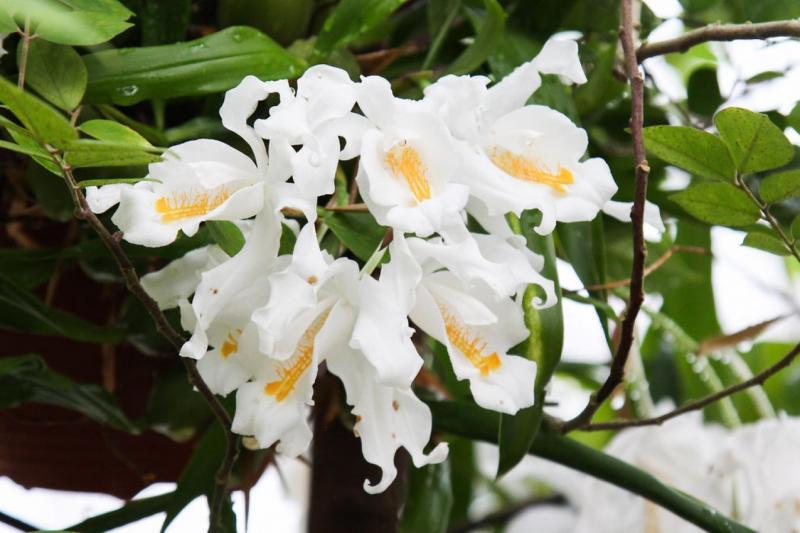Coelogyne cristata
Also known as: The Crested Coelogyne or Pleione speciosissima Coelogyne cristata h.f. alba Coelogyne cristata var. hololeuca Coelogyne cristata h.v. lemoniana Coelogyne cristata h.v. maxima Cymbidium speciosissimum Coelogyne cristata f. hololeuca in the subfamily: Epidendroideae
Native to: India Nepal Thailand
General Information
The Crested Coelogyne is a sympodial cool to warm growing epiphytic orchid belonging to the sub family Epidendroideae native to India, Nepal and Thailand. The name refers to the keels of the lip.
Plant Description
Sympodial. Grows to 15-30cm. Each new growth has numerous leaves that grow to 12-25cm long. Pseudobulbs grow to 5-7.5cm
Flowers
Numerous fragrant blossoms appear
Fragrance
The orchid is fragrant.
Substrate(s)
- Coarse
- Bark
- Charcoal
- Spaghnum Moss
- Perlite
Care Notes
This orchid goes into a dormancy phase during winter, during this phase it is best not to provide water unless the plant is starting to look thirsty. The lack of water increases the chance of flowering in spring, and also reduces the likelihood of any rot forming. Do not resume watering until new growth has appeared and is growing strongly.
Often a period of intense growth occurs after dormancy. During this time the amount of light, water and fertiliser the plant receives will directly impact the amount of growth that occurs during this time, and in the case of seedlings, will reduce the time required to reach maturity.
It's recommended to heavily reduce the water amount at the middle to end of autumn to trigger dormancy. Leaves on older bulbs will begin to drop during this time while the newer bulbs continue to mature until terminal leaves appear at the tip of the pseudobulbs.
Repotting can be done any time of the year though it's best to do it in early spring when new growth is appearing as this also means new roots will appear to help the plant anchor into the new media and offset any damage to established roots during the repotting process.
Fragrant:
- IsFragrant
Climate
These orchids grow in cool climates, at low altitudes, in cool plains, forests or coastal scrub.
They are forgiving of humidity variances as long as temperatures are kept on the cool side. They can do well outdoors in the garden in cool and temperate areas, though it is important that they are protected from warm dry winds. They can enjoy morning sun especially in winter but will need protection from the hot sun in the afternoon and during summer. With some acclimatisation they may be able to receive more sun.
Grows at low to high elevations. Rainfall ranges from 5mm to 818mm per day, heaviest in July and lightest in December. Humidity ranges from 57% to 86%, highest in July and lowest in March. Temperature ranges from -2C to 21C, highest in April (13C to 21C) and lowest in January (-2C to 12C).
Fertiliser
dormant-medium-demand-orchid Use balanced fertiliser year round. Be sure to flush out excess fertiliser by running water through the media regularly year round. Apply fertiliser regularly at half strength year round. Use a low Nitrogen fertiliser during Winter. Use a high Phosphorous fertiliser during Winter.
Potting
These plants are quite forgiving and will do well repotted ever 2-3 years. The mix should be coarse, well draining, and allow space for air to move and for roots to grow.
Alternatively, these plants will also do well mounted to tree fern or cork slabs, or mounted to trees.
Best time for repotting or mounting the orchids is the end of winter when new growths start to appear. Avoid repotting during hot weather,
This plant does very well in baskets or suspended pots




















